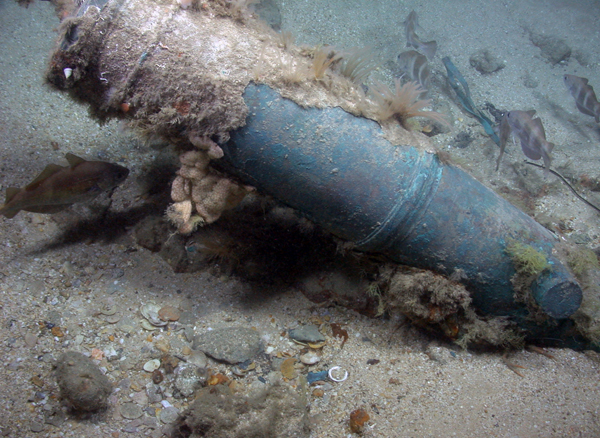Threats
Odyssey's visual survey of HMS Victory, starting in 2008 and continuing through 2013, has confirmed a pattern of ongoing natural and man-made impacts that are continuously eroding the shipwreck's structural integrity and leading to artefact losses. The site cannot be considered stable or to have reached a state of equilibrium where further impacts would be benign. The impacts have resulted in a significant loss of archaeological data and knowledge about the wreck.
The threats to Victory include:
The wreck of the Victory (1744) lies within the Western English Channel, an area heavily trafficked by fishing trawlers, lobster/crab potters and scallop dredges. Fishing plays a crucial role in today's economy and society. However, there is a need to balance these necessities with heritage management. Many nationally important shipwrecks are located within these waters. Those outside territorial waters (12 nautical miles), such as the Victory, are legally unprotected. No forms of mitigation exist to monitor site damage caused by bottom fishing.
Odyssey's monitoring of the Victory site since 2008 has documented various clear evidence of fishing impacts. Ship movement tracking through Automatic Identification Systems (AIS) has observed a continuous trawler and crab potter presence in the area. Fishing net and a lobster pot are snagged on the site. The zone where the Victory was wrecked contains the highest density of offshore fishing traffic observed by satellite Vessel Monitoring Systems anywhere within the 4,725 square nautical mile area around the site surveyed by Odyssey. The dragging of fishing gear across the seabed has displaced three-ton cannon and damaged delicate hull remains and artefacts, which are then washed away by currents. In February 2012, fishermen working across the Victory confirmed that by-catch was dumped over the wreck. Between 2008 and 2012, 100% of the archaeological areas on the Victory were impacted by these activities.
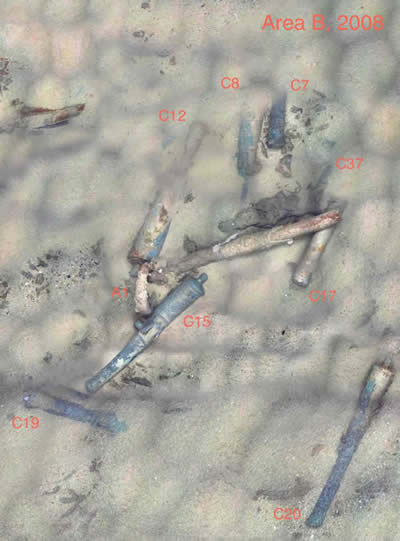 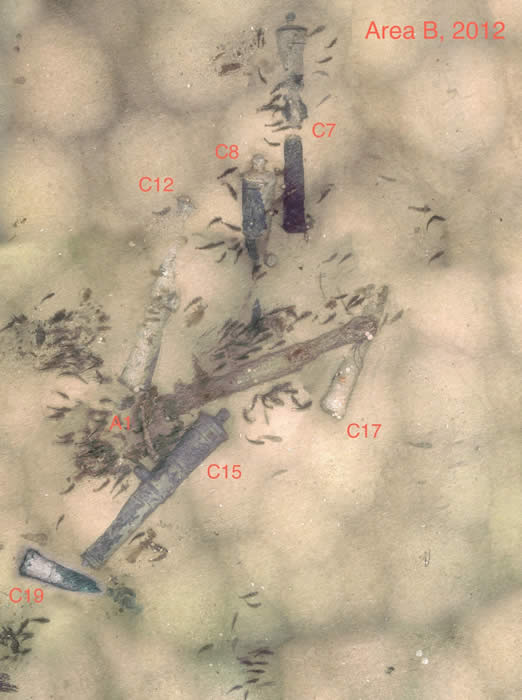 |
Photomosaic sections of cannon impacts: Area B1, 2008 and 2012. Cannon C20 present in 2008 had vanished by April 2011, having been dragged 8.5m southwest to Area E. |
Repeat monitoring has demonstrated that in their natural state, all cannon on the Victory wreck are covered with a veneer of hard concretion composed of sand, shell and gravel. Multiple bronze cannon show evidence of deep scratches and scoured surfaces caused by cable chafing. Scratches have broken through concreted cannon and have been completely or partly broken off the majority of guns on the wreck's surface. Broken concretions expose the guns' bronze surfaces to currents and natural abrasion. Under unfavourable conditions, bronze surface erosion can exceed rates of 1cm/year, bronze being naturally softer than iron.
Deep scratches, abrasion marks and corrosion on cannon C29 in Area G (left) and C5 in Area A (right) formed since 2008. |
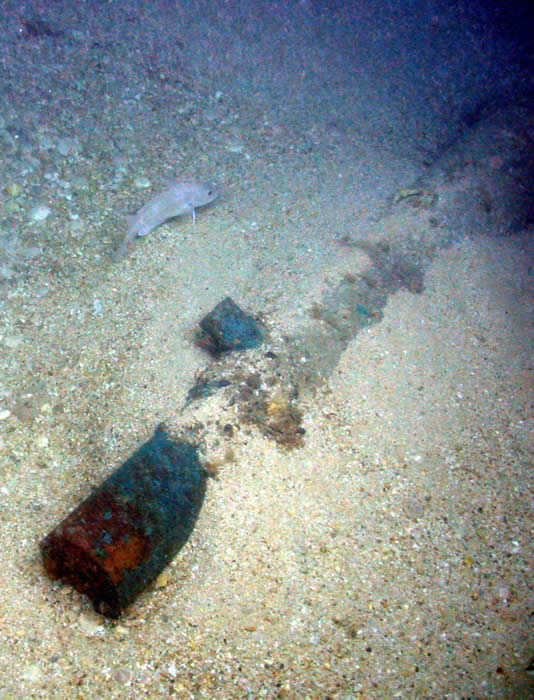 Two of Victory's cannon muzzles have clearly been sliced off. They can break for several reasons, but the available evidence points towards breakage by beam trawler gear that ploughed into them when they were protruding vertically from the sea bottom. The neck of the muzzle is the thinnest part of the cannon. Beam trawling is the only force on the seabed capable of causing such damage and also explains the concretion removal on the exposed surfaces and the recent leeching of corrosion products around the broken areas.
Two of Victory's cannon muzzles have clearly been sliced off. They can break for several reasons, but the available evidence points towards breakage by beam trawler gear that ploughed into them when they were protruding vertically from the sea bottom. The neck of the muzzle is the thinnest part of the cannon. Beam trawling is the only force on the seabed capable of causing such damage and also explains the concretion removal on the exposed surfaces and the recent leeching of corrosion products around the broken areas.
Bronze cannon C27 in Area G with concretion broken
off the trunnion and chase, and recent iron leeching.
The muzzle has been completely severed.
This breakage occurred prior to 2008.
Among the physical impacts inflicted on cannon at the Victory site, multiple guns and artefacts have been displaced and re-oriented, almost certainly due to trawlers dragging heavy fishing gear through the site. This includes a three-ton bronze cannon dragged 233m away from the wreck mound.
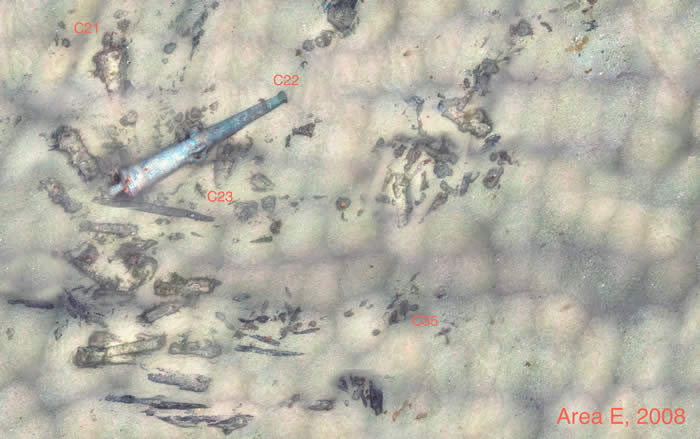 |
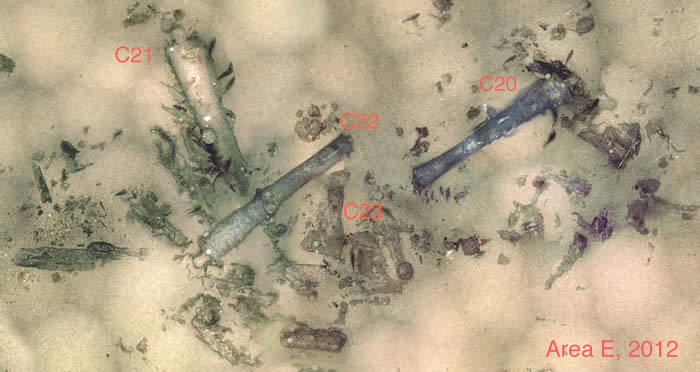 |
Photomosaic section of cannon impacts: Area E in 2008 and 2012. In between 2008 and 2011 cannon C20 was dragged 8.5m southwest from Area B1 into Area E and its chase was heavily scoured. Between 2008 and 2012 gun C21 in Area E was rotated 45º and C22 rotated and shunted 1.5m. A wooden spa alongside vanished. |
 |
Photo of the 24-pounder bronze cannon illicitly salvaged from the Victory in July 2011, inscribed 'Schalch' and '1723'. Identified as C13 from Area D. |
In July 2011, a Dutch salvage vessel used a hydraulic grab to illegally remove 24-pounder cannon C13 from Area D on the wreck of the Victory. While travelling to Holland, the Dutch ship was boarded by French customs officials. Searching for potential drugs, the sealed and intact wooden bore tampion was broken, damaging important archaeological data. Customs officials intervened in Holland, embargoed the gun and reported the find to Dutch Heritage, who in turn informed English Heritage. The state of current legal proceedings and initiatives to repatriate the cannon are unknown, although the UK Ministry of Defence has claimed the cannon as State property.
Cannon specialist Nico Brinck examined the gun and confirmed through royal arms and stamps (including the founder's name SCHALCH and the year 1723) that the cannon originated from HMS Victory (1744).
All wreck sites are vulnerable due to the nature of their marine environment. An immediate threat exists to the surface cannon and artefacts on the Victory due to on-going natural exposure, scouring and erosion of surface and near-surface remains.
An extensive concentration of hull remains visible to the far west of the wreck in 2008 had largely been washed away by 2012. Other timbers vanished.
|

